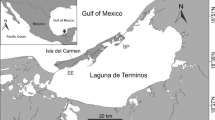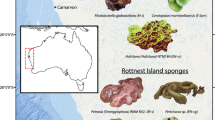Abstract
Morphological plasticity and ecological aspects of the demosponge Geodia cydonium (Jameson) were studied from seasonal samples collected over 1 year in two semi-enclosed Mediterranean bays of the Southern Italian coast (Marsala lagoon and Porto Cesareo basin). Sponge specimens present two morphs: sessile and non-sessile, both of which showed constant size distribution and density over the studied year. Sessile specimens were larger in size than non-sessile ones. This feature is particularly evident at Porto Cesareo, where these sponges have a more compact skeletal network than at Marsala (evident both in the cortical spicule size and sponge silica content). Sessile specimens adhere to hard rocky substrates (Porto Cesareo) or phanerogam rhizomes (Marsala); non-sessile ones occur on soft bottom areas. Several morphological and structural features of the non-sessile forms differ in the two environments, but the difference in body shape seems to play the most relevant role in enhancing the colonization of incoherent substrates. Indeed, at Marsala, where the large amount of silt and clay determines the occurrence of a markedly reduced anoxic layer just below the surface of the sediment, non-sessile specimens of G. cydonium are fairly spherical and thus able to roll, dragged by slow circular currents. In addition, the usual association with the red alga Rytyphlöea tinctoria, which almost constantly forms a thick and continuous layer around the sponge, allows them to avoid contact with the substrate. The non-sessile specimens from Porto Cesareo inhabit sandy soft bottoms and are flattened. In such an environment, affected by moderate wave turbulence, the flattened shape widens the contact surface between the body and the substrate, thereby reducing the risk of stranding. The evident signs of abrasion, provided by scanning electron microscopy investigations, on both cortical spicules and outermost sponge surface suggest that sponges rub on the bottom. Sediment, epibiontic organisms, and the phanerogam leaves protect this sciaphilous sponge from high solar radiation, allowing the specimens to live in these shallow environments.









Similar content being viewed by others
References
Ayling AL (1980) Patterns of sexuality, asexual reproduction and recruitment in some subtidal marine Demospongiae. Biol Bull 158:271–281
Bagander LE (1976) Redox measurements in natural waters and sediments. In: Dybern B, Ackefors H, Elmegren R (eds) Recommendations on methods for marine biological studies in the Baltic Sea. Department of Zoology, University of Stockholm
Barthel D, Tendal OS (1993) The sponge association of the abyssal Norwegian–Greenland Sea: species composition, substrate relationships and distribution. Sarsia 78:83–96
Battershill CN, Bergquist PR (1990) The influence of storms on asexual reproduction, recruitment and survivorship of sponges. In: Rutzlet K (ed) New perspectives in sponge biology. Smithsonian Institution Press, Washington, DC, pp 397–403
Bell JJ (2004) Evidence for morphology-induced sediment settlement prevention on the tubular sponge Haliclona urceolus. Mar Biol 146:29–38
Bell JJ, Barnes DKA (2000) The influence of bathymetry and flow regime on the morphology of sublittoral sponge populations at Lough Hyne MNR. J Mar Biol Assoc UK 80:707–718
Bell JJ, Barnes DKA (2002) The relationship between sedimentation, flow rates, depth and time at Lough Hyne Marine Nature Reserve. Ir Nat J 27:106–116
Bell JJ, Barnes DKA, Turner JR (2002) The importance of micro and macro morphological variation in adaptation of a sublittoral demosponge to current extremes. Mar Biol 140:75–81
Bond C, Harris AK (1988) Locomotion of sponges and its physical mechanism. J Exp Zool 246:271–284
Burton M (1932) Sponges. Discov Rep 6:237–392
Calcinai B, Bavestrello G, Boyer M, Cerrano C, Pansini M (2001) Poriferi biodemolitori e biocostruttori nella zona di marea della Bunaken Marine Reserve (North Sulawesi, Indonesia). Biol Mar Medit 8:201–208
Calvo S, Fradà Orestano C (1984) L’herbier à Posidonia oceanica des côtes siciliennes: les formations recifales du Stagnone, vol 1. In: Boudouresque CF, Jeudy de Grissac A, Olivier J (eds) Int Work Posidonia oceanica Beds. Gis Posidonie, France, pp 29–37
Congedo (1988) Studio ecologico dell’area marina di Porto Cesareo. Tiemme Industrie Grafiche. Galatina, Lecce
Corriero G (1989) The sponge fauna from the Stagnone di Marsala (Sicily): taxonomic and ecological observations. Boll Musei Ist Biol Univ Genova 53:101–113
Corriero G (1990) Distribuzione ed ecologia dei Poriferi in ambienti “confinati mediterranei”. Ph.D. thesis, University of Genova, Italy
Corriero G, Pansini M, Sarà M (1984) Sui poriferi dell’insenatura della Strea a Porto Cesareo (Lecce). Thal Sal 14:3–10
Corriero G, Balduzzi A, Sarà M (1989) Ecological differences in the distribution of two Tethya (Porifera, Demospongiae) species coexisting in a Mediterranean coastal lagoon. Pubbl Staz Zool Napoli (I. Mar Ecol) 10(4):303–315
Corriero G, Sarà M, Vaccaro P (1996a) Sexual and asexual reproduction in two species of Tethya (Porifera, Demospongiae) from a Mediterranean coastal lagoon. Mar Biol 126:175–181
Corriero G, Scalera Liaci L, Mercurio M (1996b) Il popolamento a Poriferi della Riserva Marina di Porto Cesareo. In: Riass 57th Cong Naz UZI. San Benetto del Tronto, Italy, pp 28
Frøhlich H, Barthel D (1997) Silica uptake of the marine sponge Halichondria panicea in Kiel Bight. Mar Biol 128(1):115–125
Gaino E, Manconi R, Pronzato R (1995) Organizational plasticity as a successful conservative tactic in sponges. Anim Biol 4:31–43
Genchi C, Calvo S, Lugaro A, Ragonese S (1983) Idrologia di una laguna costiera e caratterizzazione chimico-fisica dei sedimenti recenti in relazione alla distribuzione dei popolamenti vegetali sommersi (lo Stagnone di Marsala). Quad IRPEM 4:23–34
Gherardi M, Giangrande A, Corriero G (2001) Epibiontic and endobiontic polychaetes of Geodia cydonium (Porifera, Demospongiae) from the Mediterranean Sea. Hydrobiologia 443:87–101
Guide VG (1976) Sponge predation in the oyster reef community as demonstrated with Cliona celata. J Exp Mar Biol Ecol 25:109–122
Hartman WD (1958) Natural history of the marine sponges of southern New England. Yale University Bulletin 12, Peabody Museum of Natural History, Yale University, New Haven, CT
Hill MS, Hill AL (2002) Morphological plasticity in the tropical sponge Anthosigmella varians: responses to predators and wave energy. Biol Bull 202:86–95
Ilan M, Abelson A (1995) The life of a sponge in sandy lagoon. Biol Bull 189:363–369
Jørgensen CB (1944) On the spicule-formation of Spongilla lacustris (L) 1 The dependence of the spicule-formation on the content of dissolved and solid silicic acid in the milieu. K danske Vidensk Selsk Biol Skr (19)7:1–45
Jørgensen CB (1947) On the spicule-formation of Spongilla lacustris (L.) and Ephydatia fluviatilis (L) 2 The rate of growth of the spicules. K danske Vidensk Selsk Biol Skr (20)10:1–22
Kaandorp JA (1991) Modelling growth forms of the sponge Haliclona oculata (Porifera, Demospongiae) using fractal techniques. Mar Biol 110:203–215
Kaandorp JA (1999) Morphological analysis of growth forms of branching marine sessile organisms along environmental gradients. Mar Biol 134:295–306
Kaandorp JA, de Kluijver MJ (1992) Verification of fractal growth models of the sponge Haliclona oculata (Porifera) with transplantation experiments. Mar Biol 113:133–143
Labate M (1968) Ecologia dei Poriferi di acque superficiali di “Porto Cesareo” (Mar Ionio). Boll Zool 35(4):348
Magazzù G (1977) Usefulness of the Marsala lagoon for acquaculture. Nutrients and primary production. Rapp P-v Réun Comm int Explor scient Mer Méditerr 24(6):81–82
McDonald JI, Hooper JNA, McGuinness KA (2002) Environmentally influenced variability in the morphology of Cinachyrella australiensis (Carter 1886) (Porifera: Spirophorida: Tetillidae). Mar Freshw Res 52:79–84
Mercurio M, Corriero G, Scalera Liaci L (1997a) Sulla forma non sessile di Geodia cydonium (Jameson) in un ambiente superficiale. Biol Mar Medit 4(1):407–409
Mercurio M, Scalera Liaci L, Corriero G (1997b) Modificazioni morfologiche in esemplari non sessili di Geodia cydonium (Jameson) (Porifera, Demospongiae). In: Riass 58th Congr Naz UZI. Cattolica, Italy, 39 pp
Mercurio M, Corriero G, Scalera Liaci L, Gaino E (2000) Silica content and spicule size variations in Pellina semitubulosa (Porifera, Demospongiae). Mar Biol 137:87–92
Mercurio M, Scalera Liaci L, Corriero G (2001) La fauna a poriferi del bacino della Strea di Porto Cesareo (LE). Biol Mar Medit 8(1):403–412
Molinier R, Picard J (1953) Notes biologiques à propos d’un voyage d’étude sur les côtes de Sicile. Ann Inst Océanogr 28:163–188
Palumbi SR (1984) Tactics of acclimation: morphological changes of sponges in an unpredictable environment. Science 225:1478–1480
Palumbi SR (1986) How body plans limit acclimation: responses of a demosponge to wave force. Ecology 67:208–214
Parenzan P (1976) Un habitat marino di tipo subtropicale a Porto Cesareo. Atti VI Simp Naz Cons Nat, Bari, pp 151–157
Passeri L (1974) Sedimentazione carbonatica attuale e diagenesi precoce nella laguna di Porto Cesareo (Penisola Salentina). Extra Suppl Boll Geol It 92:3–40
Pè J (1973) Étude quantitative de la régulation du squelette chez une éponge d’eau douce, vol 84. Archs Biol, Bruxelles, pp 147–173
Pulitzer-Finali (1983) A collection of Mediterranean Demospongiae (Porifera) with, in appendix, a list of the Demospongiae hitherto recorded from the Mediterranean Sea. Ann Mus Civ St Nat Genova 84:445–621
Relini G (2003) Il biofouling Parte Prima: il macrofauling. Biol Mar Medit 10(Suppl):285–326
Riggio S, Sparla MP (1985) Notes on fauna inhabiting Rytyphlöea tinctoria (Clem) C Ag aegagropyla in the stagnone Sound (Western Sicily). Rapp Comm Int Mer Medit 29(4):143–144
Rutzler K (1997) The role of psammobiontic sponges in the reef community. Proceedings of the Eighth International Coral Reef Symposium, vol 2, pp1393–1398
Santucci R (1922) La Geodia cydonium come centro di associazione biologica. In: Mem CIII Com Talas It. Premiate officine Carlo Ferrari (ed) Venezia, pp 5–20
Sarà M, Vacelet J (1973) Ecologie des Démosponges. In: PP Grassé, Masson et Cie (eds) Traité de Zoologie, vol 3. Spongiaires. Paris, France, pp 462–576
Schönberg CHL, Barthel D (1997) Inorganic skeleton of the demosponge Halichondria panicea. Seasonality in spicule production in the Baltic Sea. Mar Biol 130:133–140
Stone AS (1970) Seasonal variation in the gross biochemical composition of Hymeniacidon perleve (Montagu). J Exp Mar Biol Ecol 5:265–271
Uriz MJ (1981) Estudio sistemático de las esponjas Astrophorida (Demospongia) de los fondos de pesca de arrastre, entre Tossa y Calella (Cataluña). Bol Inst Espa Oceano 6(320):8–58
Vogel S (1981) Life in moving fluids—the physical biology of flow. Willard Grant Press, Boston
Wulff JL (1985) Dispersal and survival of fragments of coral reef sponges. Proc Int Coral Reef Symp 5:119–124
Wulff JL (1991) Asexual fragmentation, genotype success, and population dynamics of erect branching sponges. J Exp Mar Biol Ecol 149:227–247
Wulff JL (1995) Effects of a hurricane on survival and orientation of large erect coral reef sponges. Coral Reefs 14:55–61
Acknowledgements
This work was financially supported by the Italian Ministero dell’Università e della Ricerca Scientifica e Tecnologica funds (ex MURST 40 and 60%). All the experiments complied with the current Italian laws.
Author information
Authors and Affiliations
Corresponding author
Additional information
Communicated by R. Cattaneo-Vietti, Genova
Rights and permissions
About this article
Cite this article
Mercurio, M., Corriero, G. & Gaino, E. Sessile and non-sessile morphs of Geodia cydonium (Jameson) (Porifera, Demospongiae) in two semi-enclosed Mediterranean bays. Marine Biology 148, 489–501 (2006). https://doi.org/10.1007/s00227-005-0092-4
Received:
Accepted:
Published:
Issue Date:
DOI: https://doi.org/10.1007/s00227-005-0092-4




